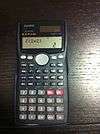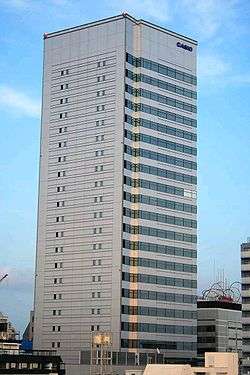Casio FX-502P series
 A 30-year-old Casio FX-501P in working condition displaying the number π | |
| Type | Programmable Scientific |
|---|---|
| Manufacturer | Casio |
| Introduced | 1978 |
| Calculator | |
| Entry mode | Infix |
| Precision | 12 digits mantissa, ±99 exponent |
| Display type | LCD Seven-segment display |
| Display size | 10 + 3 Digits |
| Programming | |
| Programming language(s) | Keystroke (fully merged, Turing complete) |
| Memory register | 11 (FX-501P) 22 (FX-502P) |
| Program steps | 128 (FX-501P) 256 (FX-502P) |
| Interfaces | |
| Ports | one vendor specific |
| Connects to |
Compact Cassette via: |
| Other | |
| Power supply | 2×"G13" or 2x"LR44" |
| Power consumption | 0.0008W |
| Weight | 141g, 5 oz |
| Dimensions | 15.24x7,6x1.2 cm, 6"×3"×½" |
The FX-501P and FX-502P were programmable calculators, manufactured by CASIO from 1978. They were the predecessors of the Casio FX-601P and Casio FX-602P.
Arithmetic
The FX-502P series use the algebraic logic as was state of the art at the time.
Display
The FX-501P and FX-502P featured a single line 7-segment liquid crystal display with 10 digits as main display. An additional 3 digits 7-segment display used to display exponents and program steps when entering or debugging programs and 10 status indicators. The display was covered with a yellow filter, supposedly to prevent ultra-violet radiation damage.
Programming
The programming model employed was key stroke programming by which each key pressed was recorded and later played back. On record multiple key presses were merged into a single programming step. All operations fitted into one program step.[1]
The FX-501P could store 128 steps, with 11 memory registers. The FX-502P had double capacity with 256 steps and 22 memory registers.
Conditional and Unconditional jumps as well as subroutines where supported. The FX-502P series supported 10 labels for programs and subroutines called P0 .. P9. Each program or subroutine could have up to 10 local labels called LBL0 .. LBL9 for jumps and branches.
The FX-501P and FX-502P supported indirect addressing both for memory access and jumps and therefore the programming model could be considered Turing complete.
Since the FX-501P and FX-502P only employed a Seven-segment display each program step was represented by a special 2 digit codes made op of the digits 0 .. 9 and the character C, E, F and P. The Calculator came with a special overlay[2] so the user need not memorise the mapping between code and actual command.
What differentiated the 501/502P from its competitors was that programming was retained in a battery-buffered memory when the calculator was turned off. Texas Instruments And Hewlett Packard had comparable devices but without the constant memory capability.
Programming example
Here is a sample program that computes the factorial of an integer number from 2 to 69. For 5!, you'll type 5 P0 and get the result, 120. The whole program is only 9 bytes long.
| Key-code | Display-code | Comment |
|---|---|---|
| P0 | P0 | You'll call the program with the P0 key |
| Min0 | C6-00 | stores the value in register 0 |
| 1 | 01 | starts with 1 |
| LBL0 | F0-00 | label for the loop |
| * | E1 | multiply |
| MR0 | C7-00 | with M0 |
| INV DSZ | FF-01 | Decrements M0 and Skips next command if M0=Zero |
| GOTO0 | F1-00 | Go to LBL0 |
| = | E5 | end of loop, the machine has calculated |
Interface
| Connects to |
FX-502P series and FX-602P series Compact Cassette via one of:
|
|---|---|
| Manufacturer | Casio |
| Introduced | 1979 |
| Type | Compact Cassette Interface |
The FX-501P and FX-502P used the FA-1 to store program and data to Compact Cassette using the Kansas City standard. The FA-1 also enabled the calculators to generate musical notes.[2]
References
- ↑ FX-602P Token list - note that the FX-502P series only employed the standard plane.
- 1 2 casio fx-501p with programming overlay
External links
- FX-501P and FX-502P on RS-Key maintained by Viktor Toth.
- FX502P Geek on casio.ledudu.com
- casio fx-501p and casio fx-502p on Voidware
- FX-502p Simulator

